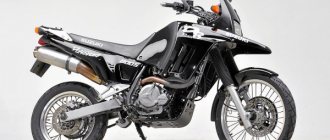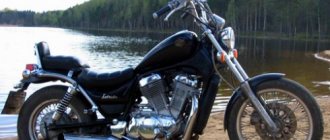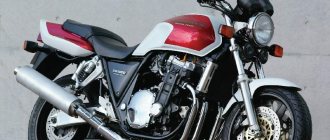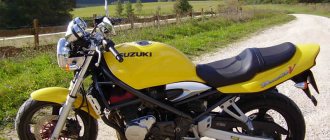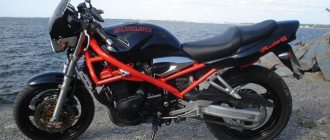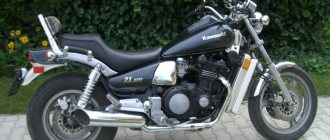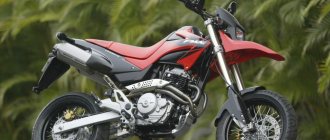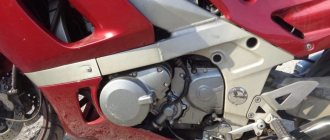Review of the Suzuki VX800 motorcycle
“Viksa” is an excellent motorcycle, underrated in our country, which, in principle, is quite standard. In our country, motorcycles are judged by price, and the price of a Vixa is the same as a four hundred, despite the fact that it has an 800cc Truder engine. Good device 
Everything is relative. For me, the VX was the first normal Japanese motorcycle. Before him I rode a Chinese one, and a little earlier on various Soviet motorcycles of my friends.
So, the VX800 is powerful, reliable, durable, and inexpensive. In Germany they love him, in Japan they love him, in the Russian Federation for some reason not so much. They say he's not a chopper, not a classic. This is bullshit. This is a real motorcycle, made of normal metal with a classic V-twin of decent volume for real men!
The car is really big, I even think it’s healthy. If you get the hang of it, it’s very maneuverable in traffic jams and in the city.
In fact, the designers seem to have been given the task of making a motorized tank. They did it. A 1990 device fell into my hands! During the season I only changed the oil and installed new mirrors! Almost every day I go to work and back, which is 50 km one way in traffic jams. Fuel consumption is 5-7 liters. 9 liters if you burn it. A normally adjusted VX goes to 100 in 5.1 seconds, and reaches a maximum of 180 km per hour. more is possible, probably, but after 140 it’s a kick, not a control. At this point it drives, steers and brakes normally. If you have any questions about the motorcycle, write to: Nevzorovvasili (at)yandex.ru
By the way, due to its weight, the mots is not particularly forgiving of mistakes, and therefore I don’t think that as a first one it is the best.
Among the diverse Suzuki model range, this model occupies a special place - judge for yourself: V-twin, driveshaft, classic twin shock suspension. This at least strange combination has gained fans in the old and new worlds; in Germany there is still a club for VX800 owners, although more than 15 years have passed since the end of the model’s production.
The appearance of the motorcycle fully corresponds to the concept of “left-hand thread” - it is not like others, it is easily recognizable. If you look at it from the front, you get the impression that it is a chopper, which is helped by the Intruder turn signals, chrome and the bend of the steering wheel.
The landing seemed close to ideal to me - straight, classic, with slightly bent legs in the Suzuki tradition. The feet immediately find the footrests, the hands are comfortably placed on the steering wheel, which is slightly more curved than on other classics. The butt is moderately soft, there is room to move back or closer to the tank when taxiing in the city. Let me note that my height is 184, my weight is about 95 kg. It seems that the motorcycle was originally created for solo riding, because... The rear footrests are too raised, my wife often had numb legs, at the same time there is a rear yoke and the seat width is quite decent.
The instruments are easy to read in any weather; the white backing with chrome trim looks unusual and is pleasing to the eye. The presence of a tachometer on the wind turbine, as it turned out, is not at all necessary, because the speed is felt through vibrations and traction, but it is a pleasant bonus. The front fork never raised any questions - it always handled all the irregularities clearly, and never broke through, although many complain about its excessive softness. It is possible that progressive springs were installed in Japan and the previous owner filled in oil with a viscosity of 15W (for those suffering, you can order springs with a progressive characteristic at louis.de). The rear stock shock absorbers initially puzzled me with their strange operation, but after adjusting the rebound dynamics they began to please me; I did not adjust the spring preload - I was quite happy with the preset one. Unfortunately, it was not possible to find a universal setting, so before traveling with a passenger I had to set the regulator to position 4 - the hardest.
The acceleration dynamics are quite sufficient for the city, somewhat more vigorous than usual 800x intruders due to adjustments and the height of the cams on the camshaft, which made it possible to expand the operating speed range. It's lucky from almost idle, gets a slight kick after 2500 rpm and spins vigorously up to 6000 rpm, then the dynamics begin to fade. According to the manual, you should fill in gasoline with an octane rating of at least 91. Practice has shown that nothing changes when moving from 92 to 95, so I filled it with 92. The tank is enough for 200 km in the city and just under 300 on the highway.
The brakes are quite consistent with the dynamics of the motorcycle, the rear one is very grippy, when riding solo I recommend being more gentle with it - it is possible to lock the rear wheel. It is worth paying tribute to - when blocked, the rear does not start walking and the trajectory does not change. Things are worse with the front - it is not as efficient as expected from a modern all-purpose motorcycle, a single disc brake and a two-piston caliper are good for a chopper, but not for a road bike.
The gearbox seemed a little harsh for a road worker, but all shifts occur clearly, with a clear metallic sound, there are no mishaps (and this is on a 20-year-old motorcycle!) The clutch is a little tight, the left hand got tired at first during long city rides, after a few weeks it got used to it, and then I didn’t remember about this little bug.
Riding around the city is easy for this motorcycle thanks to its small width, water cooling prevents it from overheating even in the deadliest traffic jams, and the sound of the standard exhaust is audible to motorists, but at the same time it is not annoying when riding at night in courtyards. By the way, the stock mufflers are made of thick steel; when dropped, they do not crumple, but act like arcs; their ends are especially affected - on most VX800s I have seen, there are scratches and abrasions right at the end of the mufflers, which affects the appearance. The pipes are resistant to corrosion, but tend to turn yellow over the years.
All maintenance operations can be done by yourself and I will not particularly mention them, with the exception of two sore points - the front air filter. What I would break the Suzuki designers' leg for is this filter. In order to get to it, you need to remove: the seat, the tank, in some cases the side linings of the steering column, then pull off the rubber pipe going to the carburetor and pull the airbox out from under the wires and cables. Next, we change the filter element, after wiping the inside of the box with a damp cloth to remove all dust and repeat the Kama Sutra in the reverse order.
The simplest spark plugs are suitable for 150-200 rubles each, but replacing the spark plug for the rear cylinder is a separate perverse pleasure. The standard intruder spark plug wrench from Luis will not fit there; it can only replace the spark plug in the front cylinder. There are 2 options - modify it a little by cutting off 1.5 cm from the top and drilling a new hole for the knob. I did something different - I found a thin-walled head, an extension, 2 cardan shafts and a knob. This design, albeit perverted, is very convenient to work with.
Unlike Intruders, the battery on the VX is located in a human-like manner, under the seat and is easily accessible. The standard size is easily found in any motorcycle store. The only inconvenience during the replacement was caused by the terminal wires; they had no reserve in length.
When cleaning carburetors, I recommend paying special attention to rubber membranes - they tend to lose elasticity and tear. You can seal it as a temporary solution, but it is better to order new ones from catalogs and for both carbs at once.
Another feature regarding carburetors is that in cold weather (less than 10 degrees) it is difficult to start the engine; at near-zero temperatures it is almost impossible to start without pre-heating the carbs. I took a household fan heater and directed it alternately to the front and rear carbs, the entire warm-up took about 5-10 minutes, after which I started it by briefly pressing the starter button. It happens that on a motorcycle that has been standing for a long time, the rear cylinder does not work stably; this problem goes away with warming up. Nobody knows how to treat it, apparently, it’s a design feature.
Recommendations for those wishing to buy the VX800 and owners:
The motorcycle is quite heavy (220kg) and tall, so try it on and think about how you will lift it, God forbid. When dropped, the ends of the mufflers, the front turn signals and the steering wheel are mainly damaged - it can bend a little, and the headlight rim and instrument glasses are also scratched. I think it’s worth installing the arcs. They are definitely not on sale for free - you don’t have to look, you can order them on louis.de or in any other foreign online store. Racks for vyksa are very rare, so, apparently, you will have to sculpt them yourself or have a good welder.
A windshield, in my humble opinion, will be useful in long-distance travel; in the city and suburbs it is of no use, and the appearance deteriorates.
Fine gasoline filters are simply vital; installing them takes 5 minutes, but they can seriously extend the service life of carburetors using our fuel. When replacing the air filter, don’t be lazy and rinse the gas tank - it won’t hurt. The oil in the gearbox can last for many years, but it seems to me that it’s still worth changing it once a season, since the filling capacity is just over 100g. and the operation is elementary. I prefer to change the engine oil once every 5t.km on any vehicle, unless the instructions specify more frequent replacement, fortunately the process is not labor-intensive, and the filter is cheap.
I recommend checking the condition of the wheel bearings and steering column immediately after purchase - the years take their toll, and japas, contrary to popular belief, also break)
By the way, I found a large selection of consumables on louis.de, including cables, pads and even progressive springs for the fork. There is no point in bringing the battery and oil from there, but you can get confused with filters, pads, cables, and the clutch in the winter; the shipment to St. Petersburg takes on average 3 weeks, taking into account delays at customs. It makes sense to fit into group orders, then the delivery cost is shared by all participants. In terms of modifications, in my opinion, the device is quite balanced, so if you want to get confused, then look towards the front brakes and forks. There is information that the stays fit from the GSF600 Bandit, which has 2 brake discs in front and a two-piston caliper for each of them. The brake machine can be taken from there; the standard one will not work due to its low performance. The easiest thing I see is to buy a used fork complete with wheel and brakes. Here another problem arises - the diameter of the front wheel on the Bandit is 17, on the Vyksa it is 18, i.e. you will have to play with tires or change the rear wheel. I gave you space for thought, then you do it yourself)
Bottom line: I consider the Suzuki VX800 a real universal motorcycle, suitable for the city and long-distance driving. Undoubtedly, many will not be interested in it due to its specific appearance and dynamics slightly better than the inline 400, but balanced riders will appreciate its low-end traction, brutality and simplicity of design. The price is slightly higher than the CB400, making it a good option for those who want to get a lot of motorcycle for little (even ridiculous) money. For owners of domestic equipment, the VX may become the first Japanese, because it is not for nothing that it is called the “Japanese Ural”.
For me, the Suzuki VX800 was the first Japanese motorcycle, and I really regret that I decided to sell it in favor of a more powerful and cubic one. In the future I plan to get it up again, modify the brakes and do a little magic with the carburetors. Otherwise, I am completely satisfied with it, despite all its shortcomings.
This is my second season riding on Vyksa, I really like it. There are vibrations, but for me it’s tolerable - it’s not some kind of limousine. Consumption ranges from 5.5 to 7.5, depending on how you drive. According to the speedometer, it increased to 200. It rides quite comfortably up to 160 km / h, but my windshield is tiny, without it at 120 it’s like hitting a wall with your head. It eats oil, I hope because of the caps, it’s difficult to get rings in Kaliningrad. Disc brakes are on all Vyksa. It’s advisable to use both, the car is heavy.
Appearance
The simple, clear clock and narrow window are visible as soon as you get behind the wheel. The steering wheel, as befits an enduro, is very wide and equipped with a crossbar. Factory installed hand panels provide hand protection. The engine sounds like it's groaning, which is typical for these models, but after a while there's a lovely loud single-coil sound. Starting is accomplished via an automatic decompressor, much more convenient than the manual cable previously used by Suzuki. Unfortunately, he likes to stutter, but this is not a very annoying flaw. The position is upright and very comfortable, the wide tank and front end reinforce the impression that we were meant to be riding some kind of motorcycle here. But I'm just getting started and going.
Engine and exhaust
The engine is a classic V-twin, with quite pronounced “pulsation” at idle and vibration while driving.
The pulsation, however, is quite “civilized” - the bike does not “bounce” at idle and does not budge, “as a real Harley should,” but at the same time the rear wing actually shakes until you add gas, so there are vibrations. Check mark :). During active acceleration, the pulsation develops into a slight itching, although it is worth noting that no unnecessary vibration-massage effects are observed on the steering wheel. If on the Ducati my hands went numb quickly enough, then here all the feelings remained with me :). Your legs and butt are less fortunate - you feel a little like you’re on a vibration table. And to such an extent that the next time I drove onto the autobahn, I had the feeling that my legs simply could no longer stand on their legs, but were “moving” to the sides from the vibration. Not the best feeling. Regarding the exhaust, I made a “traditional” video, but, of course, it doesn’t reflect the full picture without the right microphone. In any case, you shouldn’t expect the “roar of a wounded bear” with a standard exhaust. It’s a fairly civilized “grunting” sound, although it’s quite enough to warn of your arrival without the alarms of the neighboring Ferraris going off.
Box
The gears shift smoothly and, if you select the right speed (without a tachometer, but everything is clear from the sound and vibrations), then very smoothly and without jerking, but also without clear shifting. After a couple of tries, using heel-toe switching turned out to be very convenient. On this example, protective arches were installed and the toe of the boot kept trying to poke the arch, and not the switching foot, so switching up with the heel was just right. My only complaint is that I had to catch neutral every time. On the Sibikh this is an exception; I had to poke it back and forth several times. Maybe I just had to do it more gently out of habit.
There are only 5 passes, but to be honest, I didn’t “count” and didn’t suffer much. In the absence of a tachometer, everything goes by feeling from the fifth point: if it itches, then we stick the gear higher, if it’s not higher, then we can go slower :).
By the way, regarding the cardan, I didn’t have any comments compared to a chain or belt (like on the Vulcan). All manipulations with the throttle handle are transmitted smoothly and smoothly. The only incomprehensible point was the presence of a “howl” while driving, but after 47 thousand miles of the test unit, for some reason this did not bother me much :).
On the run
In fact, the most important thing was left for last :). After driving the Vulcan, I was very interested in the issue of the autobahn and speeds of more than 100 km/h, because the Vulcan “forced” me to drive no more than 110 km/h. But before getting to the autobahn, I first made my way through a couple of villages, then along local roads (80-100 km/h), and only then the autobahn. At the same time, in search of a place for photos, a couple of times I drove at a snail’s speed. And I must say that the Suz behaves very nicely at low speed! First gear can be a little fidgety, but overall, slow maneuvering through parking lots or small paths wasn't too stressful. Everything is easy, simple and predictable. Due to the fact that many people complain about the small turning angles of cruisers, I only made a couple of fairly careful attempts to “scrape” with the footpegs, but it’s not for nothing that people write that the Intruder has the best ground clearance among its brothers. So I didn’t manage to leave any marks on the asphalt.
Getting on the autobahn is a slightly different story. The power is enough for the eyes. I don’t know how it is with the passenger, but the response to the throttle, although not sporty, is quite noticeable and very clearly visible behind the confidently creeping speedometer needle. For “some” 53 horses and 69 nm for 277 kg of weight, this is quite respectable. Let’s not forget about the cardan, which also takes its “tax” on power. The problem is created by vibrations, or rather even the itching emanating from the V-shape, which at its peak makes the whole world around tremble and blur. Up to 100 km/h this is felt only when the engine is “over-twisted”, but is solved by switching to a higher gear. But after 100-110 this itching becomes constant. We must pay tribute to the Suzu - driving 120 km/h is quite possible, and 130 is also not much different for the worse :), but comfort is “presence of absence”. I didn't have any big problems with overtaking. Yes, not from 120 to 160 with a slight turn of the throttle, as on the Sibich, but the characteristics are not the same, and as a bonus, the likelihood of leaving your license in your pocket is much greater :). In general, such a movement gave me a very mixed impression - it seems like “it’s possible”, but on the other hand, driving like this all day is no joy. Unless you “lower” to “cargo-truck” speed or even take detour routes at a speed of “up to a hundred.” What pleased me was the excellent visibility in the mirrors even at a speed of over one hundred. If on the “Sibikh” most of the mirror is occupied by the rider himself, then here the rider is visible only at the edge, and everything else is the road, and without any cloudiness from vibrations. Great!
The small windshield didn’t add any comfort either, which made my helmet bounce around as if I was driving right behind a truck in a turbulence zone. It seems that it is better either without it (you still can’t go more than 120 :)), or set it to high. By the way, despite the rising wind, there was no windage observed. Or maybe over the past couple of years I just got used to it and became less sensitive to such natural phenomena :).
Comparison with C1500BT
When I came back, I involuntarily remembered the “big brother” C1500BT. It turns out that “everything is the other way around”: at low speed the “one and a half liter” did not feel very comfortable, but on the autobahn it “puffed” very impressively at 140 km/h. But the 800 effortlessly drives at a snail's pace, but on the autobahn it strains to keep up with the others.
PS
In general, the ideal package, as for me, should include bags, a passenger “backrest” (English sissy-bar), and, perhaps, a set of additional lamps (popularly “chandelier”) for solidity in addition to the windshield and roll bars installed on this specimen. And for non-chrome lovers like me, the BT option (in the States BOSS, or Blacked Out Special Suzuki) is generally the ultimate dream.
Share link:
- Click here to share content on Facebook. (Opens in a new window)
- Click to share on Twitter (Opens in new window)
- Click to share on Pinterest (Opens in new window)
- Click to share posts on Tumblr (Opens in new window)
- Click to share on LinkedIn (Opens in new window)
- Send this to a friend (Opens in new window)
DR800 design
The motorcycle has a fairly modern engine. Air-oil cooling, which protected the engine very well from overheating, was borrowed from sports motorcycles. Two balance shafts eliminate the strong vibrations that the 800 generates during operation. One camshaft operates four valves. The clearance is adjustable in a spiral manner. The mixture is set on fire with two candles; The TSCC (Twin Swirl Combustion Chamber) system causes greater mixture turbulence and more efficient combustion.
The motorcycle is very well thought out in this regard, and repairs can be easily carried out even by yourself, right on the road. Speaking of routes, I must mention the large 24 liter fuel tank. This, unfortunately, is not 29 (like its predecessor DR 750), and only with a sharp drive does the bike begin to run out of gas. Shifting into reserve is not a problem while driving and then we have another 5.5 liters. Unfortunately, the DR 800 ran out of fuel or even the reserve indicator. This takes some getting used to and is a flaw in a model that aspires to the term touring enduro.
A bit aesthetically pleasing, but quickly rusting mufflers are the problem with this bike. Since they were quite cheap during the model's glory days, the mufflers and the entire exhaust system (as with the entire DR series) are elements on which the manufacturer wanted to save money. The same thing happened with the varnish coatings, especially the varnish on the frame. They are not of the highest quality, but this disadvantage can be overcome, although with normal road use and regular rust removal it is quite common.
Suzuki DR 800
I would recommend the DR 800 to anyone who loves interesting motorcycles. The 800cc single is an out-of-the-box solution that is a lot of fun to drive. The motorcycle will be described as specific. It is suitable for touring because, despite its heavy weight, it performs very well in the field and provides good dynamism on the road. High torque, specific engine performance, and at the same time durability have been recognized by many owners of these motorcycles. It is worth mentioning that this motorcycle once took part in the very prestigious Parisian Dakar rally, which is probably the highest rating for it.
Post Views: 4,729
conclusions
In general, oddly enough after all the comments, I liked the bike! And at the same time, more than the Kawasaki VN900, forgive me Vulcan fans. Yes, the Kava is a little more powerful, but if you need “power”, then it comes with a larger displacement, and the Suzuki, in my opinion, is a more “weighted” device with the option of tubeless wheels, an “eternal” cardan (it seems that my weak point is I want so that “not a chain” and “not a belt” :)) and, judging by the data on Fuelly (see the converter for conversion to digestible values), a very pleasant consumption on average of about 4.9 l/100km). Another common point of mid-sized cruisers that appeals to me is that such a device allows you to use the potential every day, and this potential is enough for the eyes. With sports motorcycles everything seems “cool”, but “shooting” every day does not improve your health, and besides on the track it is of little use. Of my motorcycles, I think that I haven’t really used any of them to their full potential. And especially not getting to the track :).
After careful consideration after the test drive, I came to the conclusion that I would probably be happy to take such a device. As soon as the itch in my butt becomes unbearable and I’m ready for “anything, the main thing is something else” :). And it is quite possible that it will be Suzuki. In the meantime, there is time to think and try what else interesting is offered. Life goes on!
The price of the new device in Holland ranges from € 8,999 for the basic “chrome” configuration to € 9,999 for the black version with touring (windbreaker, leather bags) configuration. Compared to heavy tourers like my favorite, the Yamaha FJR1300 is mere nonsense :).
